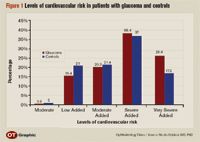Article
Survey study correlates glaucoma with cardiovascular risk
Fort Lauderdale, FL-Results of the OPTIME Study show that cardiovascular risk factors are significantly more prevalent among patients with primary open-angle glaucoma (POAG) compared with unaffected controls, reported Nicola Orzalesi, MD, PhD, at the annual meeting of the Association for Research in Vision and Ophthalmology.
Fort Lauderdale, FL-Results of the OPTIME Study show that cardiovascular risk factors are significantly more prevalent among patients with primary open-angle glaucoma (POAG) compared with unaffected controls, reported Nicola Orzalesi, MD, PhD, at the annual meeting of the Association for Research in Vision and Ophthalmology.

All subjects underwent a comprehensive ophthalmologic examination at baseline, systemic blood pressure evaluation, and completed a four-page, 52-item questionnaire to elicit information on demographics, glaucoma history, and cardiovascular risk factors. Subjects were placed in one of five categories based on levels of cardiovascular risk (moderate, low added, moderate added, severe added, and very severe added), according to guidelines from the European Society of Hypertension-European Society of Cardiology. These guidelines take into account blood pressure, cardiovascular risk factors (gender, age, smoking, physical exercise), presence of damage to end organ(s), and presence of associated clinical conditions (e.g., diabetes).

The OPTIME protocol stipulated that no center could recruit more than 100 cases, in order to ensure uniform distribution of cases and controls throughout the country. To be included in the study, glaucoma patients had to be 50 years of age or older and exhibit both glaucomatous optic disc and visual field changes. Controls were of the same age range and had to have a normal optic disc, normal visual field, and IOP <21 mm Hg. Patients with ocular hypertension were excluded in both groups.
The demographics section of the questionnaire collected information on family history of cardiovascular disease and personal lifestyle factors, including smoking, physical activity, and ingestion of coffee and alcohol. The demographic results showed the cases and controls were relatively well-matched with respect to age and gender, although the POAG group was slightly older than the controls (mean age, 68 versus 65 years old) and had a slightly lower preponderance of females (55% versus 61%).
The personal glaucoma history section showed the patients with POAG had a mean duration of disease of 7 years and were receiving a range of therapies, including topical, laser, and surgical intervention alone or in combination. The ophthalmologic exam showed IOP was slightly, but significantly, higher in the POAG group versus the controls, 16.8 versus 15.4 mm Hg, respectively.
"This is a low IOP for a group of patients with POAG, but we must consider almost all were receiving some form of treatment," Dr. Orzalesi said.
Newsletter
Don’t miss out—get Ophthalmology Times updates on the latest clinical advancements and expert interviews, straight to your inbox.




